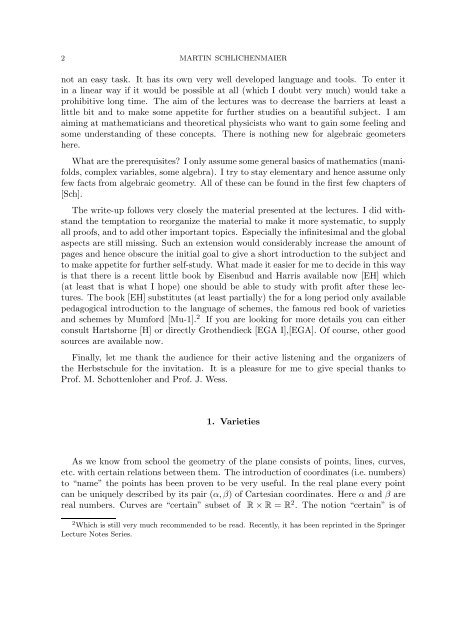Mannheimer Manuskripte 177 gk-mp-9403/3 SOME CONCEPTS OF ...
Mannheimer Manuskripte 177 gk-mp-9403/3 SOME CONCEPTS OF ...
Mannheimer Manuskripte 177 gk-mp-9403/3 SOME CONCEPTS OF ...
- No tags were found...
Create successful ePaper yourself
Turn your PDF publications into a flip-book with our unique Google optimized e-Paper software.
2 MARTIN SCHLICHENMAIERnot an easy task. It has its own very well developed language and tools. To enter itin a linear way if it would be possible at all (which I doubt very much) would take aprohibitive long time. The aim of the lectures was to decrease the barriers at least alittle bit and to make some appetite for further studies on a beautiful subject. I amaiming at mathematicians and theoretical physicists who want to gain some feeling andsome understanding of these concepts. There is nothing new for algebraic geometershere.What are the prerequisites? I only assume some general basics of mathematics (manifolds,co<strong>mp</strong>lex variables, some algebra). I try to stay elementary and hence assume onlyfew facts from algebraic geometry. All of these can be found in the first few chapters of[Sch].The write-up follows very closely the material presented at the lectures. I did withstandthe te<strong>mp</strong>tation to reorganize the material to make it more systematic, to supplyall proofs, and to add other i<strong>mp</strong>ortant topics. Especially the infinitesimal and the globalaspects are still missing. Such an extension would considerably increase the amount ofpages and hence obscure the initial goal to give a short introduction to the subject andto make appetite for further self-study. What made it easier for me to decide in this wayis that there is a recent little book by Eisenbud and Harris available now [EH] which(at least that is what I hope) one should be able to study with profit after these lectures.The book [EH] substitutes (at least partially) the for a long period only availablepedagogical introduction to the language of schemes, the famous red book of varietiesand schemes by Mumford [Mu-1]. 2 If you are looking for more details you can eitherconsult Hartshorne [H] or directly Grothendieck [EGA I],[EGA]. Of course, other goodsources are available now.Finally, let me thank the audience for their active listening and the organizers ofthe Herbstschule for the invitation. It is a pleasure for me to give special thanks toProf. M. Schottenloher and Prof. J. Wess.1. VarietiesAs we know from school the geometry of the plane consists of points, lines, curves,etc. with certain relations between them. The introduction of coordinates (i.e. numbers)to “name” the points has been proven to be very useful. In the real plane every pointcan be uniquely described by its pair (α,β) of Cartesian coordinates. Here α and β arereal numbers. Curves are “certain” subset of R × R = R 2 . The notion “certain” is of2 Which is still very much recommended to be read. Recently, it has been reprinted in the SpringerLecture Notes Series.
















